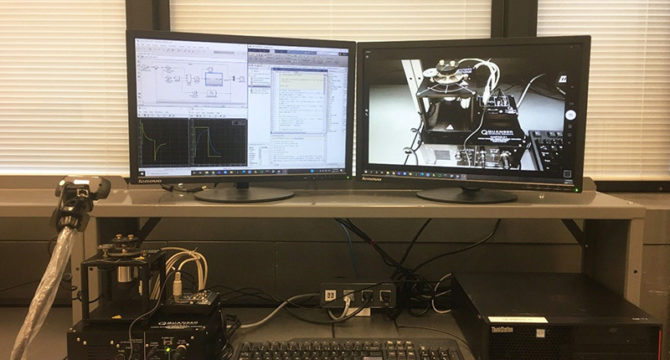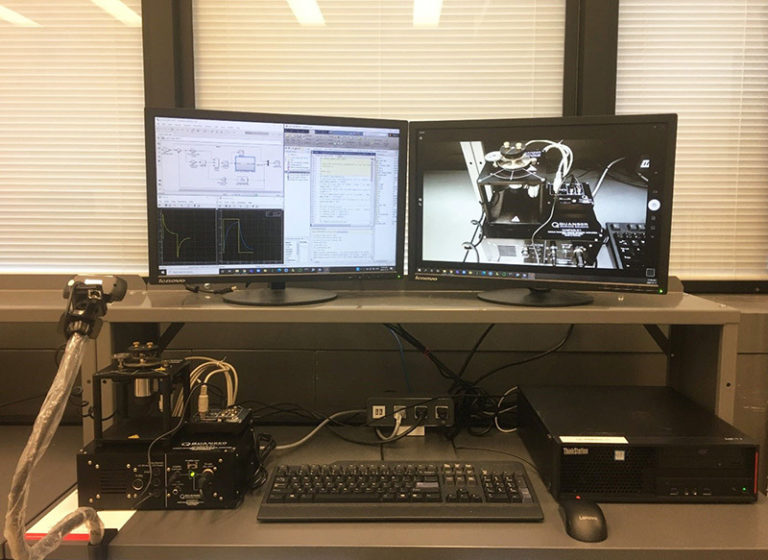A Hybrid Lab Experience: Blending Hands-on Explorations with the Flexibility of Virtualization

This article originally appeared on Quanser.
As a founding member of the Lassonde School of Engineering, the Earth and Space Science and Engineering (ESSE) department at York University in Toronto plays a key role in offering a school-wide fourth-year control theory course. With the COVID-19 pandemic requiring schools across Canada to move to an online format, the department was faced with the challenge to offer a meaningful remote laboratory experience to over 180 students enrolled in the course. By adopting Quanser Interactive Labs (QLabs), as well as remote access to physical Quanser hardware, the department was able to offer a successful hybrid laboratory experience as well as reinventing its approach to engineering labs.
Theory, Practice, and Experimentation Crucial for Control Theory Education
In the summer of 2020, Professor Jinjun Shan, Chair of York University’s ESSE department, asked for Quanser’s help in offering his control theory course completely online for the Fall 2020 semester. The 3-credit course, Introduction to Control Systems (ENG 4550), introduces students to classical control theory. From dynamic system modelling to modifying system behaviour through feedback, the goal of the course is to develop a basic understanding of control system theory and its role in engineering design. A key element of the course is a series of laboratory sessions where students are exposed to many practical control theory problems by experimenting with physical hardware plants. In the first three labs, students are introduced to the MATLAB®/Simulink® environment as well as Quanser’s QUARCTM Real-Time control software, followed by seven lab sessions covering system modelling and validation, position control, and speed control of a DC servo motor.
In the last few years, enrolment numbers have steadily increased. According to ESSE’s laboratory technician Ian Tomaszewski, the last offering prior to the COVID-19 pandemic saw over 180 registered students. Given the class size, the logistics of managing the laboratory component of the course has always been a major undertaking. What further complicated the matter was the strict rules implemented by York University for accessing the laboratory facilities during the pandemic. This meant Professor Shan had to devise a remote solution that gave students an authentic experience conducting the hands-on portion of his course.
A Hybrid Approach: Importance of Real Hardware and Flexibility of Virtual Twinning
It wasn’t until Professor Shan took over the course a few years ago that he introduced a hands-on component to ENG 4550; and when he and his team started to design the remote laboratory for the course, he insisted that a hands-on component remained, where students interact – albeit remotely – with real hardware. “There are so many tools that you could use to design and simulate a controller, such as MATLAB® and Simulink®, but I want students to see for themselves how a physical electro-mechanical system responds when they implement a controller on it, even if it’s a simple DC motor,” said Professor Shan. Other rudimentary but important factors include asking students to follow instructions in a manual to make connections between the amplifier, plant and data acquisition system.
Tasked with implementing a robust solution, Tomaszewski’s initial strategy was to use their existing Quanser Rotary Servo Base Units, set up a PC with a webcam, have students use the Windows Remote Desktop Connection app to remotely connect to the lab PC and use the Zoom teleconferencing software program to meet with their lab instructor (Figure 1).

After several successful trials, 26 stations were set up for the Fall semester. However, the logistical issues of scheduling individual remote lab sessions with large class sizes and limited servo units remained. To alleviate the issue, Professor Shan decided to incorporate a simulation component in the course. Luckily, the digital twin of the Rotary Servo Base Unit had just been released. After a brief trial, Professor Shan was confident that the QLabs Virtual Rotary Servo Base Unit would offer a meaningful hardware experience to students remotely. Several aspects of the Virtual Rotary Servo Base Unit convinced Professor Shan that QLabs was the best solution on the market. Additionally, QLabs integrated seamlessly with the existing MATLAB®/Simulink® models already used in the labs. This significantly reduced the need to revamp the existing workbooks for the course. Equally important, it allowed each student to run the labs safely, independently and at their own convenience and pace.

As shown in Figure 2, six mandatory lab activities were completed by students over a total of ten sessions. In the first two tutorial sessions, students were introduced to the MATLAB®/Simulink® environment, the QUARCTM real-time software, QLabs and the Rotary Servo Base Unit. A series of sessions were scheduled for students to connect to their Teaching Assistants via Zoom to ask questions. The remaining labs focused on modelling, speed control and position control of the inertial disc of the Rotary Servo Base Unit. The first three labs were completed using QLabs and the fourth lab was completed using remote access to the physical hardware set up in the Space Hardware Laboratory. All students were required to join Zoom sessions hosted by their TA who was physically present in the lab and remotely supported by a lab technician and course director. During the sessions, students would remotely connect to their assigned computer with the physical plant to complete their assignment.
Effective Experiential Learning
According to Tomaszewski, the lab sessions were completed without any major issues. Feedback from the Teaching Assistants as well as the students was mainly positive as well. “Students had a very good experience with the QLabs so we will continue using it even after the pandemic. One good thing about QLabs is that it can be used anywhere and anytime. Also, it provides students with a very good understanding of the hardware, helping them operate it later,” said Professor Shan
In the post-course survey, over 70% of the students agreed or strongly agreed that the combination of QLabs and remote hardware lab was an effective method of experiential learning. According to one student, “The experience was a very pleasant one. There were no issues with the lab work on the virtual labs. When the time came for the hardware labs, my experience with QLabs made the transition really smooth. I think using QLabs was a good decision, and it will be helpful for students taking this course in the future.” Another student responded, “The responses of the virtual equipment fascinated me, that they can vary so much, that the noises can be simulated so well. To be honest, I don’t know how they do it, but I would recommend continuing to use it in the future.”
As much as he emphasizes using actual hardware, Professor Shan is a firm believer in digital twinning. According to Shan, digital twinning can drive innovation and performance, and help companies improve the customer experience by better understanding their needs to develop enhancements to existing products, operations and services. The benefits of virtual twinning are not limited to teaching. They easily extend to research applications. Whether you are developing a pick and place controller for a robotic arm, a flight controller for a drone or even a lane-keeping algorithm for an autonomous vehicle, having the ability to develop and validate models in a virtual environment is safe, reduces development time and is less costly.
Digital twinning is not a new technique. NASA was the first to dabble with twinning technology as far back as the early days of space exploration. This technology (the innovated mirrored system) was used when disaster struck Apollo 13 to allow engineers and astronauts to determine how they could rescue the mission. Today, NASA uses digital twins to develop new recommendations, roadmaps and next-generation vehicles and aircrafts.

involving QLabs and remote hardware
The current pandemic, with all its hardships, has forced most universities to reinvent their approach to engineering labs. So, what will engineering labs look like at the ESSE department moving into the future? For the Fall 2021 semester, Professor Shan plans to implement a hybrid approach, blending the convenience of QLabs balanced with the tangible experience of using real hardware. Learning through experimentation, whether virtually or using real hardware, is one of the most effective ways of developing the cognitive skills required for critical thinking, such as problem-solving and systems thinking. These abilities are key identifiers of the success of engineering graduates in the industry. By providing students access to physical labs along with virtual self-paced labs, Professor Shan hopes students will have the tools that allow them to exceed the course learning outcomes.
Professor Jinjun Shan is the Chair of the Department of Earth and Space Science and Engineering at York University. He is an internationally recognized expert in the areas of dynamics, control, and navigation. He joined York University in 2006 and was promoted to Full Professor in 2016. Dr. Shan has made outstanding contributions to several national and international space missions including the NEOSSat. He has attracted over $5 million in research funding from various governmental agencies and industry partners. Dr. Shan’s accomplishments in research and engineering education have seen him recognized with prestigious recognitions such as the Fellow of Engineering Institute of Canada (EIC), the Associate Fellow of AIAA, Alexander von Humboldt Fellowship, JSPS Fellowship, York Research Leader Awards, and Excellent in Teaching Award. He is the founding director of Spacecraft Dynamics Control and Navigation Laboratory (SDCNLab) at York University.